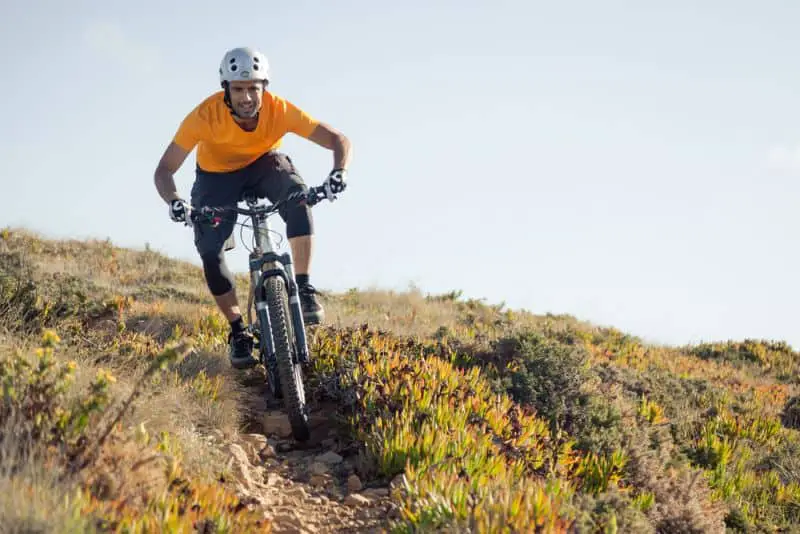Last Updated on November 14, 2022
Speed is an important part of mountain biking. It is what drives mountain bikers to ride their bikes more often as it gives a sense of excitement and thrill.
This also challenges cyclists because it means beating their previous records and proving that they have the competitive drive to improve and become better at the sport they love.
But one of the most common questions asked in the industry is how fast can bikes go? This article aims to answer that question and provide more details about the things that affect bike speed.
The factors, average speed, and other information about bike speed are all laid out here in deep detail.
Mountain Bike Average Speed
Cross-country
The average speed of mountain bikes depends on the bike type. But the ones that go fastest on average, whether it be on downhills and uphills are cross-country bikes. They average around 20 to 50 KPH and even can reach a maximum speed of 60 KPH because they are light and are usually made from carbon fiber. They also have very little rolling resistance.
Trail
Trail bikes are also considered hybrid bikes because they are versatile bikes. They are the slowest kind of bike because they are meant for leisure biking only. These bikes aren’t usually used for races which means they aren’t meant for speed.
However, most trail bikes can still reach an average bike steady speed of up to 40 to 50 KPH, but it takes more effort for the rider as these are just ideal for flat surface riding. Trail bikes also have knobby tires so they won’t easily slip on mud or rocky sections.
Enduro and downhill
Enduro and downhill bikes are made for extreme racing. This means they can go to speeds of up to 70 or even 80 KPH, but on high-speed downhill flow sections. Enduro bikes are unfortunately slow on uphills, but they are still capable.
They can even reach 10 to 20 KPH top speed on climbs which is the same speed as trail bikes, as long as they have 12-speed drivetrains, high PSI tires, and carbon fiber frames.
Downhills bikes are the heaviest, and they can barely go uphills. However, they can go very fast on downhill trails because they are very stable on even the gnarliest of sections.
Factors Affecting Bike Speed

Bike frame
The bike frame has a huge effect on your speed. The heavier your bike is, the slower you will go. On the other hand, light bikes can go faster. You also need to exert more effort if you have a heavy bike because it requires more effort to pedal.
The heavier bikes are those that are made of steel and aluminum alloy material, with the former much heavier than the latter. Most bikes today are made of alloy. Meanwhile, the lightest types of bikes are those made of carbon fiber.
These are high-end bikes that have expensive price tags. Nonetheless, their price is pretty much worth it because of their lightweight characteristics.
Aside from that, they are also stiffer to riders. This means that they are more nimble and responsive because the carbon material doesn’t absorb the vibrations and impact from the ground.
Tires
Tires also play a huge role in your bike’s speed. Unlike fat tires, thinner tires make your bike go faster because it doesn’t get too much drag. It also has a smaller ground contact compared to fatter trail-oriented tires.
Road bike tires are the fastest and lightest tires in the bike world because they only have widths of 1.3 to 1.5 mm. Compare these road bike tires to the thicker and knobby mountain bike tires that range from 1.8 to 2.5 mm.
There are even 2.7 mm width tires reserved for plus-sized bikes. The tire tread pattern also affects speed.
Related: Is It Harder to Ride a Mountain Bike on the Road?
Cross-country mountain bike tires are thinner compared to trail, enduro, and downhill tires. They usually have smaller knobs for high-rolling speeds.
Meanwhile, enduro and downhill tires have large knobs that provide maximum traction to avoid slipping on huge rocks and slippery mud.
Endurance and stamina
You can go faster if you have lots of stamina and endurance. We suggest you ride your bike daily if you want to go faster because your cardiovascular health will improve.
This then leads to better and more efficient oxygen circulation and body. Your lungs also expand and become more capable of accumulating air that allows you to go faster and pedal harder on your bike.
Gearing
Gearing means the drivetrain gear you are pedaling in. Mountain bikes have a cassette at the bike composed of multiple cogs ranging in gear where the chain is running through.
You put your chain on the largest cog by shifting the lever if you want to tackle steep uphill climbs.
You then adjust it slowly by gradually shifting to the smaller gears if you want to increase your speed. This means that you can go faster if you are running on the smaller gears. The same goes for riding downhill sections where you need to be on the smaller cogs to ride faster.
Clothing
Clothing plays a huge role as well because mountain biking goes through aerodynamic drag. This is also the reason why cross-country bikers, just like road cyclists, wear lycra because of its smooth texture that improves airflow and is more aerodynamic.
However, mountain bikers don’t always wear lycra because it doesn’t provide much protection compared to the thicker and more durable trail mountain bike clothes, even if they increase aerodynamic drag.
Related:
Terrain
You’ll surely go faster if you are riding a smooth, wide, and open downhill section. You then go slower on climbs.
But it’s not always like this because technical downhills can make you slower. After all, you avoid crashing onto big rocks. Light and flow enduro trails are the best places to ride if you want to go as fast as possible.
Distance covered
The distance you have covered also affects your speed. Your average cycling speed lowers if you ride for a longer amount of time.
This is because you start slowly to warm up your body. Compare that to short rides where you immediately burst out into speed. You also go slower if you ride for more than an hour while maintaining average commuting speed because fatigue kicks in.
Conclusion
You can ride your bike as fast as you want. But doing so puts you at risk of injury or accident. We can’t deny the fact that mountain biking depends a lot on speed. It’s what gives us the excitement, thrill, and adrenaline-rush we’ve been craving for.
However, you also need to consider many things to ensure safety. Don’t go beyond your comfort zone when you ride.
If you feel wobbly or afraid, then slowly pull the brake lever. It doesn’t mean that you’re a better mountain biker if you’re fast. Sometimes, you need to maintain that discipline for you to be the best mountain biker you can be.
